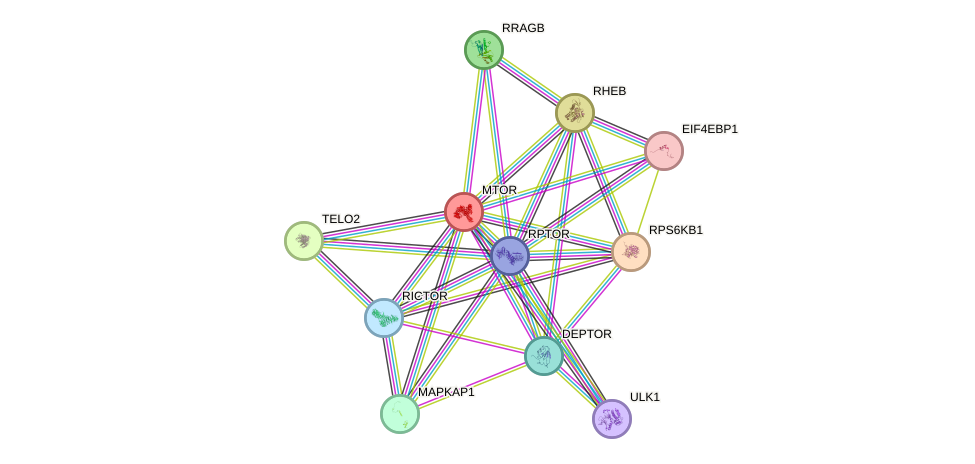GenAge entry for MTOR (Homo sapiens)
Entry selected based on evidence directly linking the gene product to ageing in a mammalian model organism
Gene name (HAGRID: 221)
- HGNC symbol
- MTOR
- Aliases
- RAFT1; RAPT1; FLJ44809; FRAP; FRAP2; FRAP1
- Common name
- mechanistic target of rapamycin (serine/threonine kinase)
Potential relevance to the human ageing process
- Main reason for selection
- Entry selected based on evidence directly linking the gene product to ageing in a mammalian model organism
- Description
The MTOR kinase belongs to the target of rapamycin group of enzymes which regulate cellular growth and proliferation [1318]. TOR enzymes, homologues of MTOR, have been linked to ageing in lower organisms. In yeast, deletions in the nutrient-responsive TOR pathway increased lifespan, and caloric restriction failed to further increase lifespan [1570]. Similarly, in roundworms, TOR deficiency more than doubled the lifespan [1319], and TOR disruption in fruit flies also extended lifespan [1317].
In invertebrates, a functional link between MTOR and insulin (INS)/IGF1 signalling has been proposed [1322], which further hints of a role for MTOR in ageing. Mice hypomorphic for mTOR have reduced mTORC1 expression, are smaller and live 20% longer [3258]. Female mice heterozygous for both mTOR and mLST8 also exhibit decreased mTORC1 activity and extended life span but have normal glucose tolerance and insulin sensitivity. While rapamycin also disrupts the mTORC2 complex, the lifespan extension is mediated through the mTORC1 complex [3628]. MTORC1 activity is reduced in the tissues of three long lived mice mutants: Snell dwarf mice (POU1F1 mutants), GHR knockout mice and PAPPA knock-out mice [4356]. In GHR knockout mice mTORC2 signalling is upregulated. Treating GHR knockout mice with rapamycin causes no further downregulation of mTORC1 but does interfere with mTORC2 and disrupts whole body homoeostasis [4493]. There, mTORC1 and mTORC2 play different roles in the ageing process.
In human cell cultures MTOR inhibition supresses the senescence associated secretory phenotype (SASP), which can disrupt tissues and contribute to age-related pathologies, including cancer. MTOR normally acts to regulate the SASP by promoting IL1A translation, which in turn promotes NFKB1 transcriptional activity [4337]. More work is needed to determine whether MTOR is associated with human ageing but it is a promising target for further research.
Cytogenetic information
- Cytogenetic band
- 1p36.2
- Location
- 11,106,531 bp to 11,262,551 bp
- Orientation
- Minus strand
Protein information
- Gene Ontology
-
Process: GO:0001933; negative regulation of protein phosphorylation
GO:0001934; positive regulation of protein phosphorylation
GO:0001938; positive regulation of endothelial cell proliferation
GO:0003007; heart morphogenesis
GO:0003179; heart valve morphogenesis
GO:0005979; regulation of glycogen biosynthetic process
GO:0006112; energy reserve metabolic process
GO:0006207; 'de novo' pyrimidine nucleobase biosynthetic process
GO:0006281; DNA repair
GO:0006468; protein phosphorylation
GO:0006914; autophagy
And 82 more GO terms Cellular component: GO:0000139; Golgi membrane
GO:0005634; nucleus
GO:0005654; nucleoplasm
GO:0005737; cytoplasm
GO:0005741; mitochondrial outer membrane
GO:0005764; lysosome
GO:0005765; lysosomal membrane
GO:0005789; endoplasmic reticulum membrane
GO:0005829; cytosol
GO:0005942; phosphatidylinositol 3-kinase complex
GO:0012505; endomembrane system
And 7 more GO terms
Show all GO termsFunction: GO:0001030; RNA polymerase III type 1 promoter DNA binding
GO:0001031; RNA polymerase III type 2 promoter DNA binding
GO:0001032; RNA polymerase III type 3 promoter DNA binding
GO:0001156; TFIIIC-class transcription factor binding
GO:0004672; protein kinase activity
GO:0004674; protein serine/threonine kinase activity
GO:0005515; protein binding
GO:0005524; ATP binding
GO:0016301; kinase activity
GO:0019901; protein kinase binding
GO:0019904; protein domain specific binding
And 3 more GO terms
Protein interactions and network
- Protein-protein interacting partners in GenAge
- TP53, TERT, STAT3, IRS1, AKT1, EGFR, NBN, PRKCD, BRCA1, VCP, ABL1, PML, GSK3B, PRKCA, TERF1, SIRT1, MAPK8, YWHAZ, SUMO1, NFKBIA, MTOR, SIRT7, IKBKB, SQSTM1, RICTOR
- STRING interaction network
Retrieve sequences for MTOR
Homologs in model organisms
- Caenorhabditis elegans
- let-363
- Danio rerio
- mtor
- Drosophila melanogaster
- Tor
- Mus musculus
- Mtor
- Rattus norvegicus
- Mtor
- Saccharomyces cerevisiae
- TOR2
- Schizosaccharomyces pombe
- tor2
In other databases
- GenAge model organism genes
- GenDR gene manipulations
- A homolog of this gene for Caenorhabditis elegans is present as let-363
- LongevityMap
- This gene is present as MTOR
- CellAge
- This gene is present as MTOR

